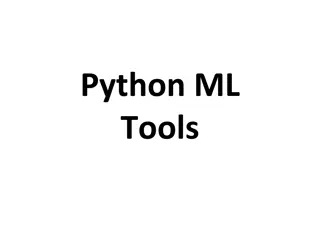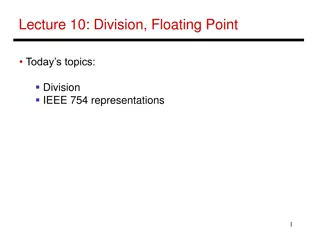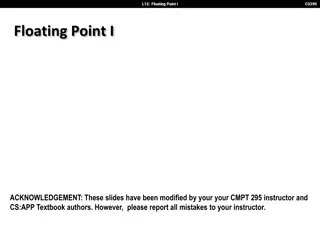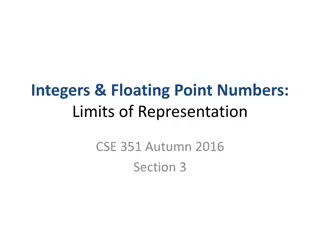Understanding Floating Point Computations in Network Design Problems
Explore the challenges of working with numerical results in network design, including identifying essentially zero values and avoiding floating-point comparison pitfalls. Discover how to use machine epsilon for accurate computations and address common formulation issues in path optimization.
Download Presentation

Please find below an Image/Link to download the presentation.
The content on the website is provided AS IS for your information and personal use only. It may not be sold, licensed, or shared on other websites without obtaining consent from the author. Download presentation by click this link. If you encounter any issues during the download, it is possible that the publisher has removed the file from their server.
E N D
Presentation Transcript
Flows to Paths B Dr. Greg Bernstein Grotto Networking www.grotto-networking.com
Working with Numerical Results Fact Link-Path and Node-Link formulations of network design problems produce a lot of variables whose values are essentially zero. Problem How do we tell if a floating point number is essentially zero? Never, ever, ever do this: If x == 0.0: # Bad, Bad, Bad, Terrible, Terrible!!! Print X is zero # WRONG!!!!!!!!
Floating point computations Will the following loop ever exit? It adds a smaller and smaller number to 1.0 and then checks if the result is equal to 1.0 Try this in any language you like (this is not a Python specific result) Theoretically what should the code do?
Floating Point Computations Loop terminates rather quickly Result This is sometimes called the machine epsilon (or twice this value).
Floating Point in Python Python (like Java, C, C++) has information on numerical accuracy and limits See sys.float_info (need to import the sys module)
Quick Check Flow variable xflow = 0.0001 Is this essentially zero? What if I told you the demand was 10Tbps? xflow does seem essentially zero when compared to the demand.
Floating point comparisons Never check for equality between floating point numbers! Absolute error check: abs(x y) <= small_number Where small_number >> machine epsilon Relative error check: abs(x-y) <= rel_err*RelatedNumber abs(x-y) <= rel_err*[abs(x) + abs(y)] Where rel_err >> machine epsilon
Example from Code Looking for links used to satisfy a demand Compare the size of the link flow relative to the demand it should help satisfy (use machine epsilon)
Node-Link Formulation Issue Does a feasible solution always lead to realizable paths? Comments in P&M page 111 & exercise 4.2 If so how can we get the paths from the flow variables? Reference: D. P. Bertsekas and D. P. Bertsekas, Network Optimization: Continuous and Discrete Models. Athena Scientific, 1998.
Link Flows ??? a variable for each link and each demand, many are zero in a typical solution Link capacities ??(we ll have a variable per link)
Graph Flows I Definition Given a directed graph G=(V,E) a flow is an vector of value ?? for each link ? ?. Definition The divergence vector ??for a node ? ? is given by ??= ?? ?? ? ??????? ???? ? Note: ???= 0 We say node v is a source if ??> 0, a sink if ??< 0, and a circulation if ??= 0. ? ???????? ???? ?
Graph Flows II Definition A simple path flow is a flow vector that corresponds to sending a positive amount of flow along a simple path, i.e., given a path P with forward and backward link sets ?+ and ? , we have (? > 0): ? ?? ? ?+ ? ?? ? ? 0 ?? ?????? ??=
Graph Flows III Definition A path p conforms to a flow vector x if ??> 0 for all forward links of P and ??< 0 for all backward links of P, and furthermore either P is a cycle or else the start and end nodes of P are a source and sink for x respectively. Conformal Realization Theorem A nonzero flow vector x can be decomposed into the sum of t simple path flow vectors ?1,?2, ,?? where t is less than or equal to V+E (the number of nodes and edges). For a proof see http://web.mit.edu/dimitrib/www/LNets_Chapter%201.pdf http://web.mit.edu/dimitrib/www/LNets_Chapter%201.pd f http://web.mit.edu/dimitrib/www/LNets_Chapter%201.pdf
Algorithm Implementation in Python Finds flows specific to a demand pair (not in general) File: flow_paths.py Function flowToPaths(demand, gflow) demand -- a pair of nodes identifiers indicating the source and sink of the flow. gflow -- a list of nested tuples (edge, flow value) where edge = (nodeA, nodeB) returns: a tuple of a list of the paths loads and a list of the corresponding paths
Helper function (Python) Search the solver solution values of the flow variables for "non-zero" link demand values. File: flow_paths.py Function getDemandLinks(demands, link_list, flow_vars, no_splitting=False) demands -- a demand dictionary indexed by a demand pair and whose value is the volume link_list -- a list of links (edges) of the network as node tuples. flow_vars -- a dictionary of link, demand variables. In our case we are working with the solutions that have been returned from the solver. These are of type PuLP LpVariables. returns: a dictionary indexed by a demand pair whose value is a nested tuple of (link, load) where link is a node pair (tuple).























